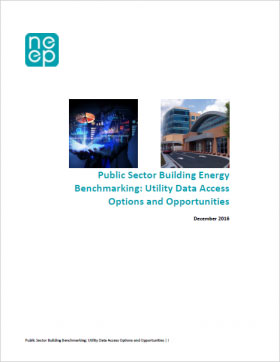By Charlie Taylor | Mon, December 12, 16
Picture yourself as an energy manager for a large portfolio of buildings. You are responsible for monitoring and reducing energy consumption in these buildings to reduce energy costs. You have just learned that you will be responsible for achieving a 20% energy reduction portfolio-wide over the next 5 years. Excited to dig in to this work, you decide to request the utility bills for all of the buildings over the last two years.
Weeks later, after working with staff in multiple departments to track these bills down, you find yourself buried under a pile of paper utility bills and wonder “how am I ever going to do this?”
Building Energy Benchmarking
Before we can think about improving the efficiency of our buildings, we need to determine how much energy they are using. In order to do that, benchmarking becomes an important process.
The United States Environmental Protection Agency (EPA) estimates that over 40 percent of the commercial building stock has been benchmarked. This process is a widely accepted first step toward reducing building energy usage, yet navigating a sea of bills and invoices spanning multiple utilities and fuel sources can be a time-consuming process not all building operators and facility managers are equipped to do.
Often, leadership will work to establish an energy reduction goal across a large portfolio of buildings and then set out to measure and manage the energy consumption of those buildings to achieve the reduction goals by a certain date. One of the biggest challenges can, in some cases, arise early in that process when energy bills from many buildings across different departments must be collected, matched to the correct buildings, and managed on an ongoing basis. This can be a massive undertaking with a virtuous end goal, but there can be significant hurdles along the way for energy managers unexpectedly buried in a mountain of paperwork.
Enter the public sector.
Since reducing the energy consumption of public buildings saves taxpayers money and lowers the environmental impacts of running the buildings needed to provide essential services, the public sector is uniquely positioned to lead by example and pioneer the efforts to manage energy consumption and achieve deep energy savings in publically-owned buildings.
There are efforts underway to streamline and automate access to building energy data. These efforts, in fact, have produced a number of public sector examples that have been successful.
NEEP’s New Resource

NEEP’s report Public Sector Building Energy Benchmarking: Utility Data Access Options and Opportunities surveys the tools used to access utility data and how municipalities across the region are using them to track usage as part of building energy benchmarking mandates. The report also highlights municipalities that serve as exemplars for accessing and using data to guide energy management decisions. It offers a series of observed best practices to help steer public entities and municipalities onto a path towards effectively meeting their energy reductions goals.
